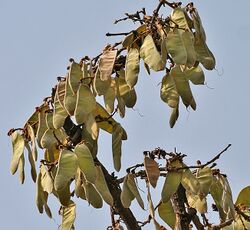Biology:Butea
| Butea | |
|---|---|

| |
| Butea monosperma flowers in India | |
| Scientific classification | |
| Kingdom: | Plantae |
| Clade: | Tracheophytes |
| Clade: | Angiosperms |
| Clade: | Eudicots |
| Clade: | Rosids |
| Order: | Fabales |
| Family: | Fabaceae |
| Subfamily: | Faboideae |
| Tribe: | Phaseoleae |
| Genus: | Butea Roxb. ex Willd. (1802), nom. cons. |
| Type species | |
| Butea monosperma (Lamarck) Kuntze
| |
| Species[1] | |
| |
| Synonyms[1] | |
| |
Butea is a genus of flowering plants belonging to the pea family, Fabaceae. It includes five species native to the Indian Subcontinent, Indochina, Tibet, and southern China.[1] It is sometimes considered to have only two species, B. monosperma and B. superba,[2] or is expanded to include four or five.[3]
Butea monosperma is used for timber, resin, fodder, herbal medicine, and dyeing.
Butea is also a host to the lac insect, which produces natural lacquer.[4]
Taxonomy
Butea is named after John Stuart, 3rd Earl of Bute (1713-1792), member of parliament, prime minister for one year, and a patron of botany.[5] William Roxburgh erected the genus Butea in 1795, but it became a nomen invalidum. Carl Willdenow validated the name Butea in 1802.
Uses
Butea monosperma, called kiṃśukha in Sanskrit, is used in Ayurvedic medicine to treat various symptoms.[6]
Species
Forty-two names have been published in Butea,[7] but forty of these are either synonyms or names of species that have been transferred to other genera.[4] Five species are currently accepted.[1]
- Butea buteiformis (Voigt) Grierson (syn. Megalotropis buteiformis, Meizotropis buteiformis) – Himalayas, India, Myanmar, and northern Thailand
- Butea monosperma (Lam.) Kuntze (syn. Butea frondosa, Erythrina monosperma) – flame-of-the-forest, bastard teak, pâlāsh – Indian subcontinent, Indochina, and southern China
- Butea pellita Hook.f. ex Prain – west-central and central Himalayas
- Butea superba Roxb. ex Willd. (syn. Plaso superba, Rudolphia superba) – India, Bangladesh, and Indochina
- Butea xizangensis X.Y.Zhu & Y.F.Du – Tibet
References
- ↑ 1.0 1.1 1.2 1.3 Butea Roxb. ex Willd. Plants of the World Online. Retrieved 14 August 2023.
- ↑ Gwilym Lewis, Brian Schrire, Barbara MacKinder, and Mike Lock. 2005. Legumes of the World. Royal Botanic Gardens, Kew: Richmond, England.
- ↑ "Butea". http://www.efloras.org/florataxon.aspx?flora_id=2&taxon_id=104910. Retrieved 11 October 2014.
- ↑ 4.0 4.1 Munivenkatappa Sanjappa. 1987. "Revision of the genera Butea Roxb. ex Willd. and Meizotropis Voigt (Fabaceae)". Bulletin of the Botanical Survey of India 29:199-225.
- ↑ Umberto Quattrocchi. 2000. CRC World Dictionary of Plant Names volume I. CRC Press: Boca Raton; New York; Washington, DC; USA. London, UK. ISBN:978-0-8493-2675-2
- ↑ Soman, I.; Mengi, S. A.; Kasture, S. B. (September 2004). "Effect of leaves of Butea frondosa on stress, anxiety, and cognition in rats". Pharmacology Biochemistry and Behavior 79 (1): 11–16. doi:10.1016/j.pbb.2004.05.022. ISSN 0091-3057. PMID 15388278.
- ↑ Butea At: IPNI
External links
Wikidata ☰ Q3322044 entry
 |


